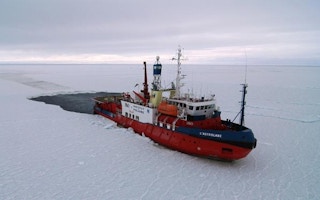It appears to have come as a major surprise to many observers, but as the crew of the Akademik Shokalskiy have discovered, there is still ice in Antarctica.
A collection of scientists and journalists were airlifted off the stranded vessel today (follow the LIVE RESCUE here), which has been trapped in Antarctic pack ice 1,500 nautical miles south of Hobart since Christmas Eve.
The farcical end to the much-hyped Spirit of Mawson expedition has led to feverish activity among climate contrarians on Twitter, claiming it’s proof global warming is over-hyped.
Earlier today the Australian newspaper ran an editorial claiming it’s a “hard lesson for those who persistently exaggerate the impact of global warming.”
“Sea ice has been steadily increasing, despite the Intergovernmental Panel on Climate Change’s gloomy forecasts,” it adds.
So in these chilly times it’s worth reflecting on what the IPCC’s latest report, which the Australian’s comment team appear not to have read, actually says about Antarctica.
Below are a few key excerpts from its ‘Summary for Policymakers’, which you can download here.
Antarctic sea ice growth:
“It is very likely that the annual mean Antarctic sea ice extent increased at a rate in the range of 1.2 to 1.8% per decade (range of 0.13 to 0.20 million km2 per decade) between 1979 and 2012.”
Reasons for sea ice growth:
“There is low confidence in the scientific understanding of the small observed increase in Antarctic sea ice extent due to the incomplete and competing scientific explanations for the causes of change and low confidence in estimates of natural internal variability in that region”
Future sea ice projections:
“In the Antarctic, a decrease in sea ice extent and volume is projected with low confidence for the end of the 21st century as global mean surface temperature rises.”
This is from the same report that said scientists are more confident than they ever have been over the causes and potential dangers of climate change.
In reality, the fact there’s lots of ice floating in the sea next to the South Pole is nothing new, and sadly does not prove the overall warming trend has stopped.
Perhaps of greater concern is the amount of ice on the mainland, as this could have major implications for sea levels.
Here’s what the IPCC says about the Antarctic’s ice sheet loss:
“The average rate of ice loss from the Antarctic ice sheet has likely increased from 30 [–37 to 97] Gt yr–1 over the period 1992–2001 to 147 [72 to 221] Gt yr–1 over the period 2002 to 2011. There is very high confidence that these losses are mainly from the northern Antarctic Peninsula and the Amundsen Sea sector of West Antarctica.”
Late last month the The European Space Agency’s Cryosat satellite revealed that 150 cubic kilometres of the Antarctic’s ice sheet are drifting into the Southern Ocean each year: a much faster rate than the calculation for 2010.
Antarctic scientists and oceanographers calculated that the melting of ice from the West Antarctic peninsula was causing global sea levels to rise by 0.28mm a year. The latest survey suggests this rate is 15% higher.
Further research
The comical end to the Mawson adventure may also have longer-term implications for research in Antarctica.
The New York Times’ Andrew Revkin reports that Australian, Chinese and French teams studying in Antarctica may have to change their plans due to the diversion of ice-breakers to help the stranded Akademik Shokalskiy.
Joe McConnell, an American ice-sheet researcher currently at the South Pole told him that, once emergency requests were sent by the Russian ship, the Australian ice breaker Aurora Australis had to turn around and cancel plans to resupply missions on the mainland.
“The short- and long-term impacts on the Australian science program are pronounced as you can imagine and I understand it is the same for both the Chinese and French programs since their icebreakers were diverted, too,” he tells Revkin.
“Many of these guys can’t complete the research they’ve been planning for years because some or all of their science gear still is on the Aurora.”
That criticism aside, bloggers at the DataSciNZ website say the expedition may have unwittingly helped raise awareness of the unsual sea ice cover in that part of the Antarctic.
“It will be interesting to unpack how the AAE [Austrasian Antarctic Expedition] leaders prepared for risk, and what information they had available,” they write.
“More broadly, it will also be very interesting to understand the reasons for the extensive sea ice cover reported around Antarctica this season, in the context of the climate system.
“In this sense, the #SpiritOfMawson may have an important but unexpected role in raising awareness.”
Ed King is the editor of RTCC.org. This post originally appeared here.










